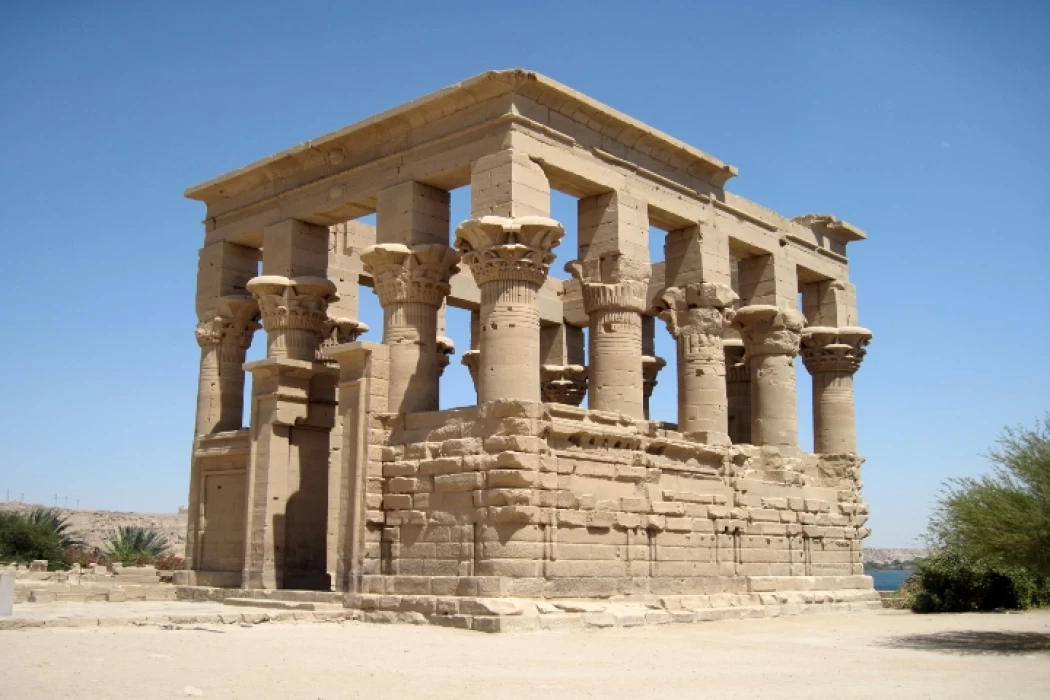
Discover The Kiosk of Trajan
Trajan's kiosk was built by Emperor Trajan, Marcus Alipius Nerva Traianus Augustus, the second of the Antonine Roman emperors, and it is called by many names, such as the Kiosk or the Pharaoh's bed.
Trajan's kiosk is an amazing ancient building located on the island of Philae in Egypt. It is one of the largest and best-preserved kiosks of all time, serving as a pharaonic gate. This architectural masterpiece was part of the temple complex of ISIS and is often associated with the Roman Emperor Trajan. However, its origins and purpose extend beyond his reign, reflecting a mixture of Egyptian and the significance of the kiosk lies not only in its historical context but also in its transportation due to the construction of the Aswan Dam, which threatened to inundate it forever.
A brief history of the site
Trajan's temple is located on the island of Philae, whose rocks used to smell in front of Aswan on the Nile and its inscriptions embrace the secrets of the character of the three Egyptian, Greek and Roman civilizations and the island is unique with its wonderful monuments such as the temple of ISIS and its magnificent temples to worship the goddess Isis.
Trajan's discovery of a kiosk. The history of the kiosk dates back to the early explorations of Philae. It is noteworthy that this construction was documented in the 19th century by leading Egyptologists. The credit for its construction is often attributed to the Emperor Trajan, who reigned from 19 to 98 AD.
Throughout history, the kiosk has experienced various cultural influences. He witnessed the rise and fall of Empires, serving as a testament to the complex past of the region. The structure was part of a larger religious landscape, which became a Christian sanctuary before succumbing to the natural elements. Its importance as a historical site is undeniable, as it has been a witness to religious transformations and political changes over the centuries. Archaeologists have not determined the exact date of the construction of the kiosk. But they agree that it was during the Roman occupation of Egypt. The structure has stood the test of time, remaining in a relatively intact condition. This is partly due to the dry climate and the sanctification of the site, which saved it from complete ruin.
Architectural description
The temple is located to the south of the temple of Hathor, which is located to the east of the temple of ISIS, and some experts believe that the structure itself may be older and may date back to the emperor Augustus. The building is a rectangular room surrounded by fourteen columns of columns with beautiful crowns decorated with inscriptions and plants, and these columns are long pillars on which the beams and hollow cornices with architectural ornaments are carried, and the pillars were designed to be carved by turning them into bell-shaped crowns (the sistrum, a percussion instrument that has become a representative cult element for Hathor) and on there are cavities inside the thresholds indicating that its roof is made of wood and was built in ancient times as this building is an example of an unusual combination of Wood and Stone are in the same architectural structure.
Frescoes and inscriptions
The reliefs show The Emperor Trajan burning incense in front of Osiris and ISIS and offering wine to ISIS and Hathor and there are wide doors on its East and west sides and a smaller door on the north side and this layout dates back to the second century AD at the time of its construction when the Emperor Hadrian came to Egypt, and the as a cool place to sit in the evening, he probably built the booth to give some kind of recreation About self.














